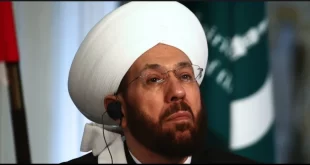Sep 13, 2013, Truthdig
In the wake of an apparent break in the march to a wider war, the reality of a nuclear dimension in Syria remains largely unspoken.
There are at least five key reasons why American military intervention in Syria’s civil war could go nuclear:
(1) There’s a reactor near Damascus.
It is relatively small, by most accounts containing about a kilogram (2.2 pounds) of weapons-grade uranium. That’s not much in the scheme of things when it comes to building an atomic bomb. But as Alexsandr Lukashevich of the Russian Foreign Ministry puts it, “If a warhead, by design or by chance, were to hit the Miniature Neutron Source Reactor (MSNR) near Damascus, the consequences could be catastrophic.”
Of prime concern would be “contamination by highly enriched uranium” throughout the immediate environs. At the very least, it would be “a serious local radiation hazard,” according to Mark Hibbs of the Carnegie Endowment for International Peace, speaking on Russia Today.
Lukashevich also predicts that “it would no longer be possible to account for nuclear material, its safety and control.” Such material, he warns darkly, could fall into “the wrong hands.”
If the U.S. does ultimately attack Syria, it would want to avoid hitting that reactor. It’s also possible that in the ensuing chaos, one of the myriad unaccountable factions roaming through the civil war could target that nuke. Such a group could blame the U.S. or claim credit, depending on its particular orientation.
Whether it happens, that reactor is just another sitting atomic duck awaiting a random shooter and the cover of new chaos.
(2) Despite Secretary of State John Kerry’s promise of an “unbelievably limited” attack, once the U.S. military commits to action in Syria, it is unlikely to hold back any of its tactical arsenal. That would almost certainly include depleted uranium (DU).
When shells made of this super-hard material penetrate armored vehicles, hardened bunkers and other structures, the DU disperses into fine radioactive particulates that are easily inhaled. Wherever deployed—as in Yugoslavia, Iraq and Afghanistan—DU inflicts horrifying health consequences, including cancer among people of all ages and birth defects among children born well after its use. Uranium-238 has a half-life of 4.5 billion years, imposing virtually permanent contamination.
Should DU weaponry be used yet again, this time in Syria, the contamination would be widespread and irreversible. Many thousands of innocent people—including the countless unborn—would suffer greatly. As with all radioactive fallout, the lethal effects will stretch through the generations.
(3) When the world’s superpowers collide, nuclear war is always a possibility.
At this point, the U.S. and Russia appear to be coming together. But in this too-often irrational global tinderbox, the stakes could not be higher.
In such situations, we hope for the best, but can’t lose sight of the potential worst.
In Tuesday night’s speech, President Obama mentioned the use of chemical weapons during World War I. He might also recall that a bizarre assassination in Sarajevo by a tiny handful of young Serb nationals somehow touched off a four-year war that killed 10 million people outright, plus another 10 million—including 500,000 Americans—in the influenza epidemic that followed.
To this day, the circumstances that sparked that war are virtually impossible to comprehend. They seem, indeed, to have somehow acquired a devastating momentum all their own.
Yet the instability of the Balkans back then pales before the flashpoint that is today’s Middle East. A protest in Syria turned into a civil war, and then a proxy war. It could easily expand into a regional and, in the worst case, global, conflict. Looming in the background of the tense, torturous negotiations yet to come is the reality that despite everyone’s best wishes, diplomatic failure is a distinct possibility—one that could ultimately become synonymous with the atomic unthinkable.
(4) In the bottomless turbulence that defines today’s Middle East, the Americans and Russians so far seem to retain some shreds of rationality. But given the Peaceful Atom’s half century of weapons-grade proliferation, we cannot know which nations or marginal groups might now have atomic devices and what random impulses might prompt their use.
In a profoundly unpredictable world, each of the more than 400 commercial-sized reactors still operating continues to produce radioactive materials that could fuel a nuclear weapon.
Each of those reactors is itself a profoundly vulnerable target. Should the situation in Syria devolve to a wider war, the likelihood of a freelance atomic “situation” becomes all too probable.
(5) While the world’s attention is focused on Syria, the global-scale disaster at Fukushima spirals out of control.
The more serious the crisis in Syria, the more it will divert attention from an existing nuclear disaster.
Millions of tons of heavily contaminated water continuously flow through the site in central Japan and into the Pacific Ocean. Millions more accumulate in flimsy tanks already breaking apart, all within the specter of the next earthquake.
The three melted cores at Fukushima Daiichi have yet to be found. The common radioactive waste pool near Unit Four is surrounded by buildings whose foundations are being undermined by the continuous flow of radioactive water.
Most terrifying, the entire core of Unit Four remains perched in a damaged fuel pool 100 feet in the air, atop a structure that’s sinking. Should it crash to the ground, that core could potentially spew into the ocean and atmosphere more than 20,000 times the radiation released at Hiroshima.
A sane species would be pouring all its resources into somehow healing the open apocalyptic wound that still festers at Fukushima.
Yet we are tied up in Syria. We can be deeply grateful that the situation there today seems at least slightly less dangerous than it did yesterday.
But atomic danger lurks without warning in every facet of this crisis.
 Syria Support Movement solidarity with the Syrian people
Syria Support Movement solidarity with the Syrian people




